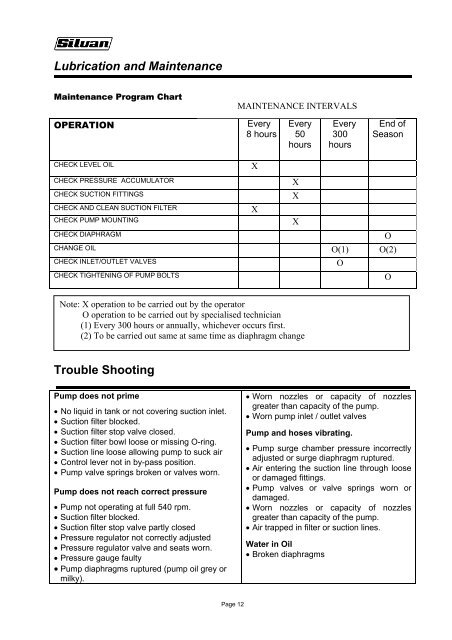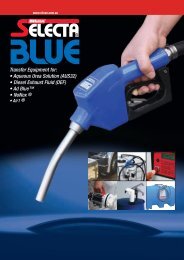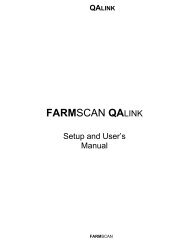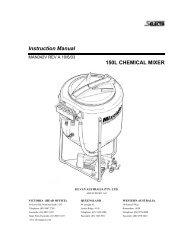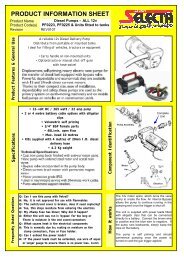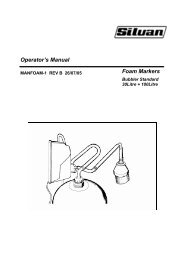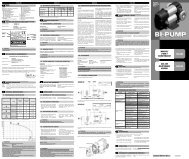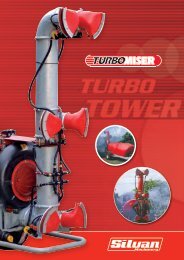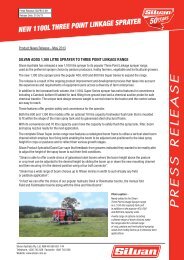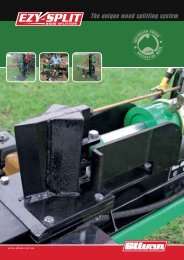Operator's Manual - Silvan Australia
Operator's Manual - Silvan Australia
Operator's Manual - Silvan Australia
Create successful ePaper yourself
Turn your PDF publications into a flip-book with our unique Google optimized e-Paper software.
Lubrication and Maintenance<br />
Maintenance Program Chart<br />
MAINTENANCE INTERVALS<br />
OPERATION<br />
Every<br />
8 hours<br />
Every<br />
50<br />
hours<br />
Every<br />
300<br />
hours<br />
End of<br />
Season<br />
CHECK LEVEL OIL<br />
X<br />
CHECK PRESSURE ACCUMULATOR<br />
CHECK SUCTION FITTINGS<br />
CHECK AND CLEAN SUCTION FILTER<br />
CHECK PUMP MOUNTING<br />
CHECK DIAPHRAGM<br />
X<br />
X<br />
X<br />
X<br />
O<br />
CHANGE OIL O(1) O(2)<br />
CHECK INLET/OUTLET VALVES<br />
CHECK TIGHTENING OF PUMP BOLTS<br />
O<br />
O<br />
Note: X operation to be carried out by the operator<br />
O operation to be carried out by specialised technician<br />
(1) Every 300 hours or annually, whichever occurs first.<br />
(2) To be carried out same at same time as diaphragm change<br />
Trouble Shooting<br />
Pump does not prime<br />
• No liquid in tank or not covering suction inlet.<br />
• Suction filter blocked.<br />
• Suction filter stop valve closed.<br />
• Suction filter bowl loose or missing O-ring.<br />
• Suction line loose allowing pump to suck air<br />
• Control lever not in by-pass position.<br />
• Pump valve springs broken or valves worn.<br />
Pump does not reach correct pressure<br />
• Pump not operating at full 540 rpm.<br />
• Suction filter blocked.<br />
• Suction filter stop valve partly closed<br />
• Pressure regulator not correctly adjusted<br />
• Pressure regulator valve and seats worn.<br />
• Pressure gauge faulty<br />
• Pump diaphragms ruptured (pump oil grey or<br />
milky).<br />
• Worn nozzles or capacity of nozzles<br />
greater than capacity of the pump.<br />
• Worn pump inlet / outlet valves<br />
Pump and hoses vibrating.<br />
• Pump surge chamber pressure incorrectly<br />
adjusted or surge diaphragm ruptured.<br />
• Air entering the suction line through loose<br />
or damaged fittings.<br />
• Pump valves or valve springs worn or<br />
damaged.<br />
• Worn nozzles or capacity of nozzles<br />
greater than capacity of the pump.<br />
• Air trapped in filter or suction lines.<br />
Water in Oil<br />
• Broken diaphragms<br />
Page 12


